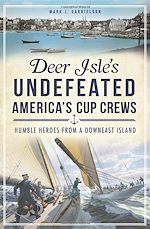  Deer Isle's Undefeated America's Cup Crews
Deer Isle's Undefeated America's Cup Crews
Humble Heroes from a Downeast Island
Mark J. Gabrielson
The History Press, 176pp, $19.99
In 2007, Deer Isle high school students researched whom among their ancestors sailed as crew on the America's Cup contenders of 1895 and 1899. What started out as an exercise in genealogy exploded into a multifaceted investigation of period mores, ethics (business and otherwise), sailing technique and strategy, boat building and design, not to mention economic history, high society, and all kinds of weather. This is a fun read even if you're not an avid racing fan.
In the 1880s until 1900 the island population was about 4000 people. The island archipelago was connected to the mainland by both bridge and ferry. Rusticators arrived in the late 1800s. The transition from sail to steam among fishing craft and other work boats came slowly to the Maine coast, primarily because wind was free. Wooden sailing cargo ships of up to six masts carrying granite and lumber were still in operation in the 1890s. Deer Islanders still knew how to sail.
During this period, Deer Isle men were already in wide circulation as big yacht commanders and crew...the advantage over other competent sailors...they were affordable. For them, the pay was better and the work was easier compared to hauling traps (from sailing craft). But..."never before or since has one town provided 'among the best large boat competitive sailing team ever assembled'" (...than those of 1893 and '99 teams).
On the other side of the pond, the first oyster smack races began in Wivenhoe in the late 1700s. There was always the impetus to develop speed to outrun revenue cutters. The first recorded race was run in 1783.
The first America's Cup race was held in 1851. (The New York Yacht Club was five years old at the time.) The schooner America won the single race off the coast of England. Rules were governed by "high Corinthian sportsmanship". Honor and fair play dominated. The largest pleasure boat field ever recorded gathered along the race course. In addition, excursion boats carried an additional 60,000 spectators.)
Years of internal turmoil in the U.S. delayed the next challenge until 1870 when Cambria (owned by Manchester builder of railroad cars, John Ashbury) defeated the U.S. Schooner, Dauntless. No crew musters survive this race. Races continued to be held with sporadic interest. Advances in sail and hull design continued to be made and rules of the race continued to be defined.
The 1893 race was distinctive for several reasons. Vigilant was the first Herreshoff designed boat. Both contenders were centerboard boats. And the crew's skill (on Vigilant) was first mentioned in the press... "a few Deer Islanders climbing like monkeys, saved the day." The first all Deer Isle crew manned Columbia in 1899, skippered by Charlie Barr.
This book is proof positive that watching a sailboat race isn't like "watching paint dry". Intrigue, honor, sneakiness and skill, heroism, dead calms and close calls are all part of this ultra-rich man's game...It just a few notches away from watching your kid jibe in her turnabout, oops, the N10.
Well written, focused and loaded with facts without being boring, and enough shenanigans to keep you reading while shaking your head.
|